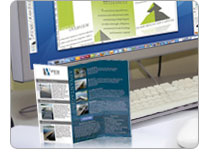- Products
-
Design Templates
- Featured Design Galleries
- More Galleries
- Services & Resources
- Free Sample Kit
- Deals
 A smart marketing brochures design is one that ensures your brochure reads easily, flows intuitively and informs its target audience. Beyond those practical considerations the goal is to make it look so spectacular that people want to pick it up and read it, and even keep it for future reference or share it with others. Here are some tips for not only achieving your goal but surpassing it with your next brochure design project:
A smart marketing brochures design is one that ensures your brochure reads easily, flows intuitively and informs its target audience. Beyond those practical considerations the goal is to make it look so spectacular that people want to pick it up and read it, and even keep it for future reference or share it with others. Here are some tips for not only achieving your goal but surpassing it with your next brochure design project:
Unless the brochure performs its practical function of presenting your client's message and other pertinent information in an easily grasped and convenient way, it won't matter how clever or creative the design happens to be. Reinforce your clients' brand by using colors carried over from other marketing tools such as logos, business cards and print ads. You can also represent your client's style through the use of appropriate fonts. Use readable fonts for essentials such as addresses and phone numbers, but keep in mind that common fonts such as Times Roman are not the only ones that are easy on the eyes. For a retro look, for example, you can go with Courier, while a font like Century Gothic offers a clean, sleek, more modern alternative.
 We are accustomed to reading a page of text from top to bottom and side to side, and then turning the page to continue the journey. While columns, boxes and pull quotes work brilliantly for brochure designs, the fact that most brochures are bi-fold or tri-fold adds other powerful options as well. For instance, you can create a large, bold tagline or headline, but have it begin on one page and continue into the interior of your brochure. The reader will instinctively open the brochure to find out how the sentence ends on the following page. Once they do, you have them engaged and involved in focusing on the content, which is the primary goal of a great brochure.
We are accustomed to reading a page of text from top to bottom and side to side, and then turning the page to continue the journey. While columns, boxes and pull quotes work brilliantly for brochure designs, the fact that most brochures are bi-fold or tri-fold adds other powerful options as well. For instance, you can create a large, bold tagline or headline, but have it begin on one page and continue into the interior of your brochure. The reader will instinctively open the brochure to find out how the sentence ends on the following page. Once they do, you have them engaged and involved in focusing on the content, which is the primary goal of a great brochure.
An important component of brochure design involves the fold, and the options for how your brochure opens and closes are wide open. For example, you can use the simple half-fold brochure style for high impact that is also low budget, or choose a letter-fold, especially if your client is planning to mail the brochure. To jazz up your brochures you can use gate folds that sort of blossom open in the reader's hands, or choose Z-folds or right-angled half folds for a custom look that immediately attracts positive attention. A well-planned brochure not only looks attractive and generates interest, but it also serves to represent both tangible and intangible features for a brand, business or individual client. Experiment with design concepts, fonts and colors, and pair your visuals with compelling text. Then let your intuition and creative juices guide you as you put it all together for a successful outcome that will keep them coming back for more.
Success! You're all signed up.